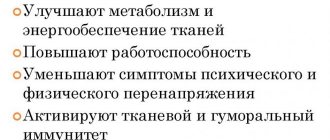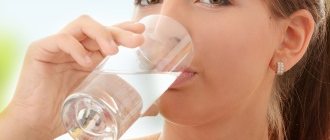Action of phenibut
It has several different effects on the nervous system and mental state:
- Reducing anxiety and fear.
- Normalization of sleep, making it easier to fall asleep.
- Nootropic effect: by improving the metabolism of nerve cells, attention, memory and reaction speed are improved.
- Relieves symptoms of dizziness, stuttering, enuresis and tics in children.
- Anticonvulsant action.
- Analgesic effect.
- Improves endurance.
The mechanism of action is complex and is associated with a direct effect on GABA receptors, which leads to increased inhibition processes caused by gamma-aminobutyric acid.
Also, by improving blood microcirculation in the small vessels of the brain and reducing the processes of lipid peroxidation, it helps restore normal metabolism of nerve cells (neurons). Thus, it combines the effect of a tranquilizer (sedative) and a nootropic-vascular drug.
How to take Phenibut for children
Phenibut has proven to be a drug with low toxicity and good tolerability, so it is prescribed for the treatment of neurotic and anxiety disorders in children and the elderly.
Phenibut for children (from 8 years old) is used in a dosage of 20 – 100 mg/day for a course of 2-4 weeks. This duration of therapy is associated with the child’s possible psychological adaptation to the medicine. The drug is prescribed to young children (less than 8 years old) by a doctor in exceptional cases. Only the doctor can decide on this. Phenibut is not recommended for infants, since the medication can have multidirectional effects on the child, which cannot be predicted in advance. Doctors advise refraining from using Phenibut for at least two years.
Children aged 8 to 14 years should take no more than 250 mg per day
Also, if necessary, it is better to give the powder, which is prepared by a pharmacist in a pharmacy, since dividing Phenibut 250 or 100 mg into correct, “children’s” doses is difficult.
| Age | Dose size per day |
| Less than 8 years | From 20 to 150 mg |
| 8-14 years | No more than 250 mg |
| Over 14 years old | Standard adult doses possible |
Indications for use
Phenibut is prescribed for both disease and non-painful conditions.
- Stress, overwork, lack of sleep, preparation for physical and mental stress and operations.
- Asthenia (asthenic syndrome, neurasthenia, VSD, astheno-neurotic state).
- Tension headache.
- Anxiety disorders: panic attacks, generalized anxiety disorder, phobias (fears).
- Neuroses, neurosis-like states.
- Personality disorders.
- Consequences of organic damage to the nervous system.
- Withdrawal state due to alcohol, drug addiction, smoking.
- Dizziness, Meniere's disease, motion sickness.
- Insomnia.
- Psychosomatic diseases.
- In children: stuttering, tics, enuresis, aggressiveness, developmental delay.
A prerequisite for taking phenibut is a doctor's prescription. Self-use is prohibited!
Adverse reactions
Non-standard manifestations occur in the initial stages of treatment, causing drowsiness, nausea, and headaches. Sometimes there is a sharp decrease or increase in blood pressure.
In some patients, Phenibut causes a number of side effects:
- increased irritability, anxiety, excitability;
- sudden dizziness, allergy symptoms (skin redness, rashes, itching).
In case of accidental overdose, patients experience:
- drop in blood pressure;
- vomiting, drowsiness, nausea;
- formation of kidney dysfunction with failure.
There is no special antidote. Therapy for the condition consists of gastric lavage and symptomatic procedures.
Phenibut addiction
With prolonged, uncontrolled use of phenibut, mental and physical dependence may develop. This may require special treatment from a psychiatrist-narcologist and subsequent rehabilitation. As a rule, cases of dependence on phenibut were observed in persons dependent on psychoactive substances who had a long history of drug addiction and who switched from using the drug to phenibut. The development of primary dependence on phenibut only after long-term use is extremely rare.
Phenibut for adults: contraindications and indications
The medication is prescribed to patients:
- with a decrease in intellectual and emotional activity;
- memory disorders, unreasonable anxiety;
- symptoms of asthenia, sleep problems, including nightmares;
- decreased concentration, Meniere's syndrome;
- alcohol dependence and the consequences of withdrawal;
- vestibular dysfunction caused by injuries, infections, and vascular diseases.
Phenibut is recommended as a complex therapy for cervical, thoracic osteochondrosis, and menopausal disorders in women. Can be used to prevent seasickness, stress that occurs during the preoperative period and before diagnosis, causing discomfort.
The annotation lists the following contraindications for therapeutic procedures:
- period of pregnancy and breastfeeding;
- presence of acute renal failure;
- children's age - up to 8 years.
Particular care is required when treating patients with gastrointestinal diseases, erosions, and ulcers. For patients, the dosage is reduced, the rule is associated with the effect of the drug, which can cause irritation of the mucous membranes of the digestive tract.
Reviews from those who have taken and are taking the drug
On the Internet you can find many reviews about the drug Phenibut, but they are all ambiguous. Some patients praise this miracle remedy, noting its high effectiveness and complete relief from primary symptoms. People write that the drug helped them cope with insomnia, anxiety and tension.
There are those who claim that phenibut improves memory and brain activity, and also increases performance. But you can also find not so positive reviews online - some people say that the drug is addictive and addictive. In any case, before purchasing a package of Phenibut, we recommend that you first consult with your doctor. So, you are guaranteed not to harm your health and will receive specialist advice on the required dosage and duration of the course. Be healthy!
The whole truth about phenibut: history of creation, benefits and side effects
advertising
Compatibility of Phenibut with drugs
Drug addicts are not interested in taking Phenibut in isolation. For them, it serves as an amplifier for the received surfactant. The most common combinations taken by drug addicts:
- With amphetamines. Euphoria becomes more pronounced and lasts longer, the “arrival” time is reduced. The negative impact on the brain and central nervous system increases. Often, amphetamine addicts taking Phenibut experience a sharp increase in blood pressure, cerebral hemorrhage or cardiac arrest.
- With butyrate. This drug causes intoxication. When combined with a nootropic, the addict feels that fatigue goes away and brain function increases for a short time. The difficulty is that this ligament often provokes uncontrollable vomiting and respiratory arrest, which leads to death.
- With marijuana. The pronounced feeling of euphoria experienced by a drug addict results in loss of consciousness and drug overdose.
- With hashish. Due to the increased drug effect, a person stops controlling himself. This ends in a fatal overdose.
Phenibut is incompatible with narcotic drugs. It cannot be taken with any surfactant at the same time.
Buy Anvifen capsules 50 mg No. 20 in pharmacies
Anvifen Buy Anvifen in pharmacies DOSAGE FORMS capsules 50mg
MANUFACTURERS Pharmproject (Russia)
GROUP Nootropic drugs
COMPOSITION Active substance: Gamma-amino-beta-phenylbutyric acid hydrochloride.
INTERNATIONAL NON-PROPENTED NAME Aminophenylbutyric acid
SYNONYMS Phenibut
PHARMACOLOGICAL ACTION Nootropic drug. Facilitates GABA-mediated transmission of nerve impulses to the central nervous system (direct effect on GABAergic receptors). The tranquilizing effect is combined with an activating effect. It also has antiplatelet, antioxidant and some anticonvulsant effects. Improves the functional state of the brain by normalizing its metabolism and influencing cerebral blood flow (increases volumetric and linear velocity, reduces vascular resistance, improves microcirculation, and has an antiplatelet effect). Does not affect cholinergic and adrenergic receptors. Reduces vasovegetative symptoms (including headache, feeling of heaviness in the head, sleep disturbances, irritability, emotional lability). When taken as a course, it increases physical and mental performance (attention, memory, speed and accuracy of sensory-motor reactions). Reduces manifestations of asthenia (improves well-being, increases interest and initiative (motivation of activity)) without sedation or agitation. Helps reduce feelings of anxiety, tension and restlessness, and normalizes sleep. In elderly people, it does not cause depression of the central nervous system; the muscle-relaxing aftereffect is most often absent. Absorption is high. Penetrates well into all tissues of the body and through the BBB. Evenly distributed in the liver and kidneys. Metabolized in the liver, the metabolites are pharmacologically inactive. Does not accumulate.
INDICATIONS FOR USE Asthenic and anxiety-neurotic conditions; stuttering, tics and enuresis in children; insomnia and night anxiety in the elderly; Meniere's disease; dizziness associated with dysfunctions of the vestibular analyzer of various origins; prevention of motion sickness during kinetosis; as part of complex therapy of alcohol withdrawal syndrome for the relief of psychopathological and somatovegetative disorders.
CONTRAINDICATIONS Hypersensitivity to the components of the drug, pregnancy, breastfeeding, children under 3 years of age. With caution: in case of erosive and ulcerative lesions of the gastrointestinal tract, liver failure.
SIDE EFFECTS Drowsiness , nausea, increased irritability, agitation, anxiety, dizziness, headache (at first doses), allergic reactions.
INTERACTION The drug, when used simultaneously, prolongs and enhances the effect of hypnotics, narcotic analgesics, neuroleptics, antiparkinsonian and antiepileptic drugs.
METHOD OF APPLICATION AND DOSAGE The drug is taken orally, after meals. The course of treatment is 2-3 weeks. Adults and children over the age of 14 years are prescribed 250-500 mg 3 times a day (maximum daily dose 2500 mg). Children aged 3 to 8 years are prescribed 50-100 mg 3 times a day; children aged 8 to 14 years - 250 mg 3 times a day. The maximum single dose in adults and children over 14 years of age is 750 mg, in patients over 60 years of age - 500 mg, in children under 8 years of age - 150 mg, in children aged 8 to 14 years - 250 mg. For alcohol withdrawal syndrome, 250-500 mg is prescribed 3 times a day and 750 mg at night, with a gradual reduction in the daily dose to the usual dose for adults. For the treatment of dizziness due to dysfunction of the vestibular apparatus and Meniere's disease, the drug is prescribed at a dose of 250 mg 3 times a day for 14 days. To prevent motion sickness, 250-500 mg is prescribed once, 1 hour before the expected start of motion sickness or when the first symptoms of seasickness appear. The anti-motion sickness effect of Anvifen increases with increasing dose of the drug. When severe manifestations of seasickness occur (vomiting, etc.), the administration of Anvifen is ineffective even in doses of 750-1000 mg.
OVERDOSE Symptoms: drowsiness, nausea, vomiting, fatty liver (taking more than 7 g), eosinophilia, arterial hypotension, impaired renal function. Treatment: symptomatic therapy.
SPECIAL INSTRUCTIONS With long-term use, it is necessary to periodically monitor liver function indicators and peripheral blood patterns. During the period of taking the drug, it is necessary to refrain from potentially dangerous activities that require increased concentration.
STORAGE CONDITIONS List B. In a dry place, protected from light, at a temperature not exceeding 25 °C.





